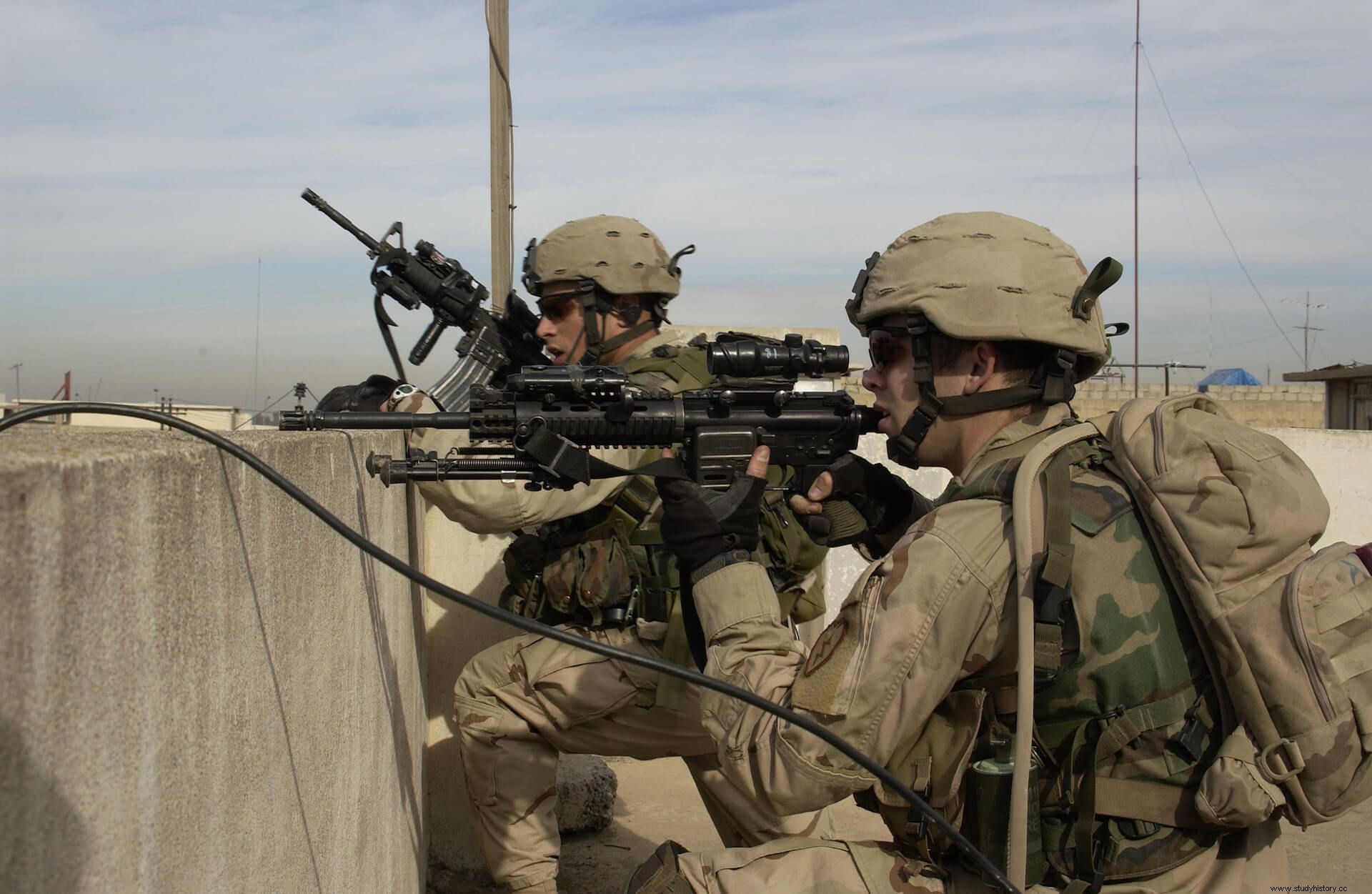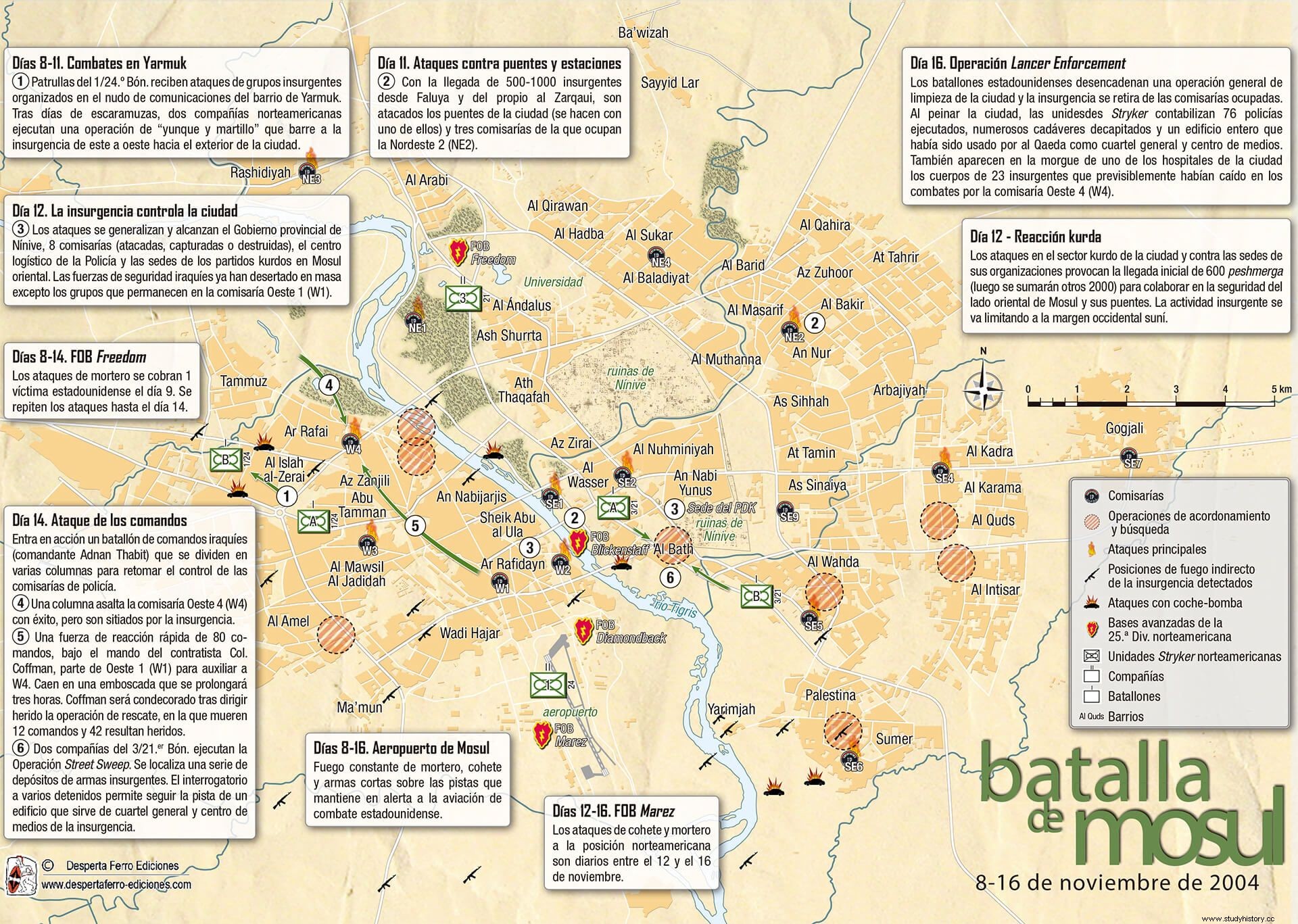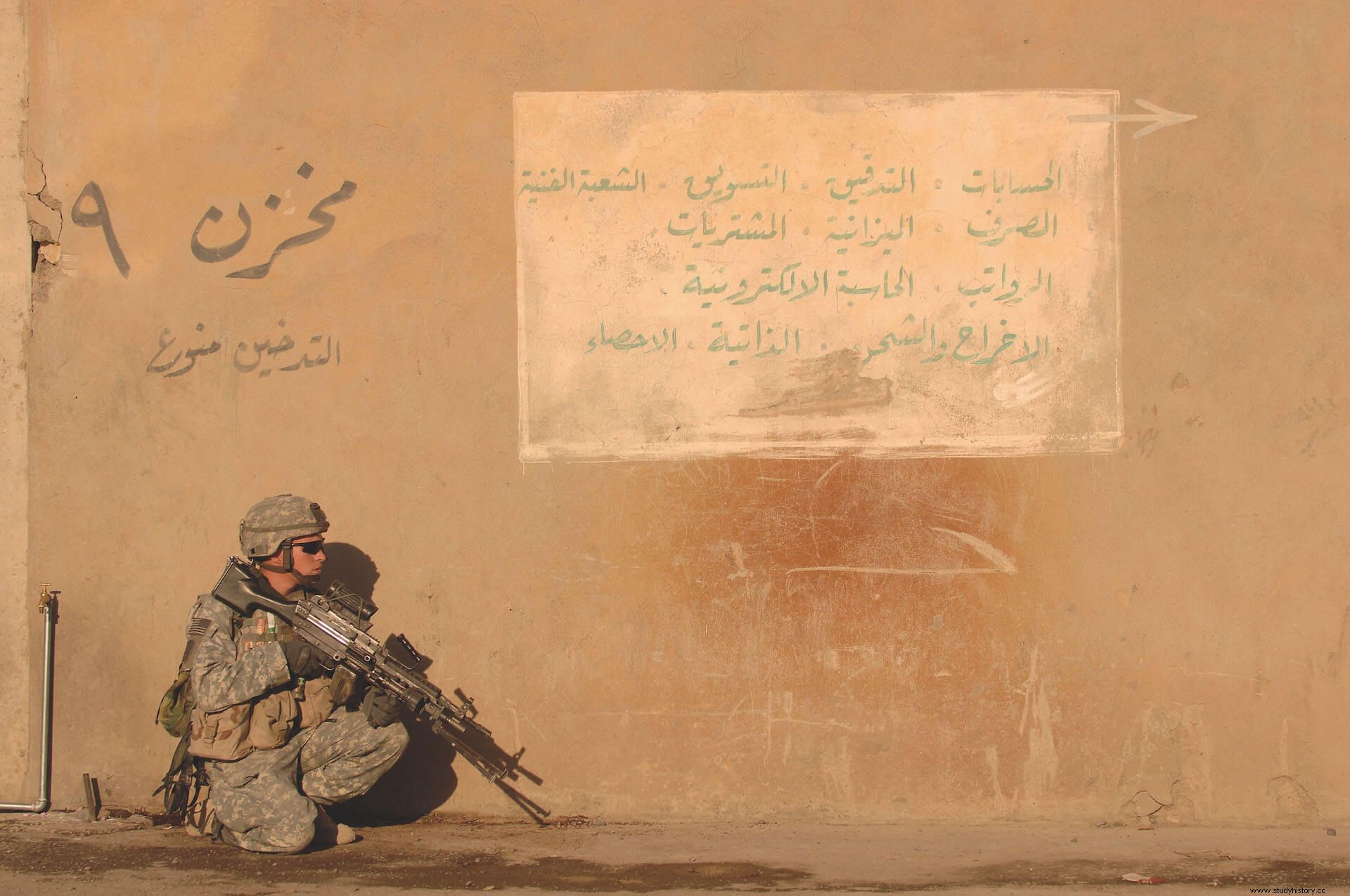
America had shed its blood and spent its budget throughout northern Iraq in its struggle to protect Mosul and its environs, and had worked tirelessly for more than half a decade to try to build up security forces that would deal reliably with the insurgent threat, which, however, disintegrated. suddenly during the Islamic State assault .
It is important to note that Mosul and northern Iraq have their own history and context of insurgent turmoil, of which the 2014 Islamic State assault is only the latest episode. This article deals with the period immediately after the US invasion of Iraq which, except for a short period of time after the 2003 overthrow of Saddam Hussein's regime in Baghdad, was characterized by the constant threat posed by a growing and developing insurgency. The resistance groups and their attacks, initially sporadic and rarely organized, became increasingly methodical and sophisticated as Operation Iraqi Freedom dragged on over the years. The mere figures show the increase of the phenomenon throughout Iraq:at the end of 2003 it was estimated at 5,000 fighters and in 2005 it had increased to 40,000 troops dedicated to the cause, plus another 200,000 volunteers and part-time fighters.
In mid-2003, northern Iraq emerged as a focus of resistance to the US occupation. Mosul and Tal Afar constituted the two main insurgent urban centers in the north, of which the first was the most important. Mosul , the third largest city in Iraq, with an estimated population of 1.8 million inhabitants and located about 400 km north of Baghdad, is known as the "Pearl of the North"; It has been for centuries a mercantile hub connecting Turkey, Iran, Syria and Central Asia, and has a long history as a melting pot of cultures, ethnicities and religions. In modern Iraq, Mosul straddles something of an ethnic divide:to the north and east, to the borders of Turkey and Iran, the main ethnic group is the Kurds; to the west, the majority is Sunni Arab with other minorities such as the Turkmen or the Yazidis. The city served as a base of operations for the Iraqi Army to suppress repeated Kurdish uprisings during the second half of the 20th century until, backed by US security guarantees, the Patriotic Union of Kurdistan and the Kurdistan Democratic Party began to administer as of 1996 the Kurdish territories in northern Iraq without interference from Baghdad. The two main ethnic groups in Mosul are Sunni Arabs (60%) and Kurds (30%) – with significant Turkmen, Assyrian Christian and Armenian minorities – and the Tigris River, which runs through the city, serves as a dividing line between the two ethnic sectors. , with the main Kurdish neighborhoods on the eastern bank and the Sunni Arabs on the western. Although both communities have lived together and intermingled for centuries, the consequences of the invasion and the rise of the insurgency have fueled tensions between them; particularly among the Sunni and Kurdish population. The former feared that the Kurds intended to dominate the city and integrate it into the area they administered, which extended to the east, and, after the capitulation in April 2003, clashes between the two erupted. Saddam's regime had settled Sunni Arabs in this oil-rich area and displaced the native Kurds, and as the invasion began, many of the former hurriedly fled before advancing Kurdish militias.
Mosul's location, close to the Syrian border, was an obvious factor for the city to become a privileged enclave for the insurgency, also favored by its orography. The urban landscape provides a conducive environment, with an extremely dense population and a winding maze of streets and old buildings, while the surrounding area contains numerous forests and groves, as well as marshy areas on both banks of the Tigris, which provide good cover for concealment. training fields and facilities. Its size allows different resistance groups to operate independently, collaborate or play against each other depending on the regional situation and the general political landscape. In early 2005, the resistance launched a series of violent suicide attacks on Shiite mosques, suggesting that Sunni Islamist groups were seeking to stoke sectarian violence, as in the rest of Iraq.
The occupation
At the start of the war, Mosul was defended by the 30,000 men of the Iraqi V Corps, although press reports indicated that there were around 120,000 troops deployed in the approximately 400 km head-on in the Mosul-Kirkuk sector . In the spring of 2003, the United States had tried to move troops into northern Iraq through Turkey; plan failed due to the refusal of the Turkish parliament to allow the transit of US troops through its territory. Later, in March 2003, the United States opened the so-called northern front by airlifting special forces to Suleimaniya, which advanced together with the Kurdish peshmerga militia. towards Mosul and Kirkuk, supported by airstrikes against Iraqi positions. On April 11, V Corps surrendered to Kurdish fighters and US special forces entered the city unopposed, with most of the Iraqi soldiers stripping off their uniforms and going home. As in Baghdad, looters who robbed banks and the Mosul Museum emerged, from which the two-millennium-old statue of King Sanatruces II disappeared. The university was also a juicy haul:the computers in the computer center had been ripped from their sockets and vehicles loaded with office furniture and scientific equipment from the campus could be seen. The fall of the city into the hands of US troops demonstrated how Mosul was a potential tinderbox for sectarian conflicts since, despite not having significant resistance against the Americans, there were a series of armed clashes between the Sunni, Kurdish and , Turkmen and Christian immediately after the surrender of the Iraqi troops.
On April 14, the first American forces to arrive in the city were met with protests and gunfire when Marines tried to raise the American flag at the Governor's office in the center of Mosul, and 10 Iraqis were killed in the confused scuffle, which boded ill. By the end of the month, elements of the 101st Airborne Division began arriving in Kirkuk and Mosul. which, under the command of General David Petraeus, would manage this sector until January 2004. The 101st Airborne was a legendary army unit, made up of 3 Brigade Combat Teams (BCT), 2 aviation and 1 artillery, plus 3 engineer battalions and 1 military police deputy, so it could boast a total force of about 17,000 soldiers. The city's population reacted disparately to his arrival; while the Kurds did so enthusiastically, the Iraqi Sunni-Ba'athists seemed more restless. It was a population strongly rooted in Mosul and from which up to 100,000 men and 1,000 generals and high-ranking officers of the demobilized Iraqi Army came, which is why, after the occupation, a city inhabitant clairvoyantly declared to a journalist that the "Baas party, the Republican Guard and the fedayeen are waiting in their homes."
The first recorded attacks on US troops took place in late April, when positions on the West Bank came under sustained machine gun and small arms fire, with four reported dead insurgents. The 101st Airborne worked hard to defuse local tensions enlisting former Iraqi Army commanders and even calling extraordinary elections in early May to elect a 24-member municipal council to take over administrative functions. A police academy to rebuild the local security forces and an employment office targeting former military personnel were quickly launched; however, as a sign of things to come, urban clashes broke out in June between US soldiers and unemployed Iraqi soldiers, and in early July, ambushes in southern Mosul on US convoys by insurgents armed with RPGs and Kalashnikov assault rifles. Despite these sporadic attacks, northern Iraq was viewed by some as a success story for America's post-conflict nation-building effort:cross-border trade with Turkey was quickly restored, and Iraqis were installed in many local government positions. The 101st was to spend $17 million in reconstruction funds.
However successful this division was, it did not stem the inexorable rise in violence, which steadily grew in intensity around Mosul as well as elsewhere. from the country. Between the spring and summer of 2003, threatening signs of what was going to happen surfaced. In early June, hundreds of demobilized Iraqi soldiers rallied in central Mosul protesting their lack of pay, and five US soldiers were injured in street clashes during two days of protests. Around that time, troops reported receiving sniper fire during their patrols through the city, then came the first ambushes on US forces and, in November, the insurgents carried out their first attack on US convoys with improvised explosive devices (IED, Improvised Explosive Devices ).
That same month, they began using the same brutal tactics as in other parts of the country:the intimidation and murder of Iraqi collaborators. They turned interpreters at the service of journalists and Americans into preferred targets, considering that they offered favorably biased coverage. In September, Sana Toma Suleiman, deputy director of the North Oil Company's petroleum products department for Nineveh province, had been killed as he took his car to work; in October, the head of the Iraqi military training center was assassinated and attacks against Kurdish party offices also took place; Already in early November, gunmen assassinated Judge Ismail Yusuf, president of the Mosul court, seriously injured Muhammad Zebari, president of the Mosul Northern Oil Company, and beheaded the dean of the law school. As a sign of its increased capacity, the insurgency shot down two Black Hawk helicopters in late November, killing 17 US soldiers. The suicide bombings began in early 2004, as the 101st was preparing to withdraw:in January, they attacked the division's base near Tal Afar, wounding 60 soldiers in the attack; in early February, a suicide bomber managed to break through a police station guardrail, killing 9 Iraqi policemen and wounding 45 others. This pattern continued for the rest of the year with attacks both on US forces and on any Iraqi accused of collaborating. with the occupation.
The insurgency
During the fall of 2003, the main lines of the organizational structure of the different insurgencies in and around Mosul emerged, which would last for years to come. In a media interview, Lt. Col. Daryl Reyes, the 101st Division's chief intelligence officer, identified several of the groups operating in northern Iraq. The Baathists had created at least two insurgent organizations:al-Rifah (“Prosperity”), made up of high-ranking soldiers, and another called al-Awdah (“The Return”), composed of former members of the Baath Party. Islamist groups had also organized:one called the Army of Muhammad was detected in the city, and a branch of the Muslim Brotherhood appeared in a poor suburb called Hamman Alil. that was fueling anti-American sentiments, a Muslim preacher jailed by Saddam's regime for sedition told a journalist, who also stated that “the longer [the United States] takes to lift Iraq, the more difficult it will be […] Those who lead operations against the Americans are those who lost their jobs. Mosul is like a little Baghdad.”
One of the most violent groups to emerge in late 2003 was Ansar al-Islam , which had long been operating in the remote northeastern regions of Iraq and whose attempts to establish command and control units in the city were detected by the 101st Division. Later, they would gain notoriety by claiming responsibility for two major attacks in Mosul:a suicide attack on the canteen of the US Forward Operating Base (FOB) in Marez in January, which claimed 22 deaths and 60 wounded; and the beheading of 12 Nepalese workers in August 2004. Ansar triumphantly uploaded the gruesome videos of the killings to a website along with claims that Nepalis were “fighting in the service of Jews and Christians against Muslims” and “regarded Buddha as their god”. The participation of Islamist groups in the insurgency was also reflected in the increase in attacks on Christian churches and those of other denominations. Following a tactic deployed elsewhere in Iraq, an Islamic fundamentalist group called the Islamic Council of Mosul distributed from mosques in the Sunni sector west of the city its letters to the "Brides of Jihad," urging women to marry foreign jihadists and requested that the names of marriageable women be included in a list for the Council.
The violence in Mosul it reached a climax in November 2004, while US troops were carrying out the assault on Fallujah in Anbar province. On November 12, some 500-1,000 insurgents attacked Mosul police stations and besieged Kurdish political headquarters, ending the police presence in much of the city. US officials were shocked by the magnitude of the attacks and some witnesses claimed that many of the policemen had joined the insurgents. What is certain is that 3,200 of Mosul's 4,000 police officers abandoned their posts during the attacks, while militants looted at least six police stations and truckloads of armed fighters roamed the city freely for two days.

The peshmerga
After the battles for Fallujah and the rise in Anbar province of the Awakening Movement [N. of the T.:tribal self-defense militias emerged under the sponsorship of the United States], many Sunni fighters made Mosul their new base of operations and it was estimated that between 500 and 700 al-Zarqawi fighters headed towards the city. Up to this point, the evolution of the insurgency in Mosul somewhat mirrored the trend elsewhere, as the Baathists and extremist Sunni Islamists initially united in their opposition to the occupation, but later diverged in their goals. At the end of 2004, Ansar al-Sunna emerged as the dominant jihadist group and its main leader, Mohammed Sharkawa, was believed to command several hundred militiamen. Sharkawa advocated the creation of a state in northern Iraq modeled on the example of the Taliban, reflecting his Salafist beliefs. The other part of the insurgency in Mosul was almost unanimously secular and comprised of former Baathists, whose two main groups financed their operations with shipments of cash from Syria.
The limits of counterinsurgency
US efforts to provide security were hampered by a lack of troops. After the departure of the 101st Division in January 2004 and its relief by the 2nd Stryker Brigade Combat 3rd Infantry Division (SBCT) – a force three times smaller than the 101st – the sheer size of the area notably complicated counterinsurgency efforts. It was clear that the insurgents had taken advantage of the reduction in US forces, compounded by the deployment of the 2nd SBTC in various operations outside the province. In January 2005, US commanders would lament that troop shortages in northern Iraq had crippled their ability to control the insurgency, but at least by the end of 2004 their strength had almost doubled in northern Iraq, to approximately 11,000 troops, as they tried to muster forces to provide security ahead of the January 2015 elections.

The breaking of the links between the forces of Coalition and the population of Mosul in 2004 was fueled by two troop rotations. In February, the 2nd Brigade of the 101st Airborne was relieved by the 3rd SBCT (2nd Division) of the Task Force Olympia . This force was unable to provide the same solidity as the previous one, limiting its ability to interact on a large scale with the local communities it sought to police. The American contingent was concentrated in two main bases, one to the north and one to the south of the city, which meant that the forces were decentralized; a practice that would later become common throughout the war.
The last rotation in 2004 was between the 3rd SBCT (2nd Division) and the 1st Brigade of the 25th Infantry Division. By the end of July, there were only 6 companies operating in Mosul, so the situation was simple:Coalition forces were not enough to consolidate the previous success of the 2003 operations. Civilian casualties increased throughout 2004 – except in June and November – as insurgents targeted police stations. Thanks to their ability to gather information and alienate the population from the local administration, the groups directly attacked the city government.
With fewer troops, the coalition was unable to maintain interaction with the population and a trained police force, and trust in the local administration disintegrated as the insurgent pressure throughout the city. At the beginning of 2005, Mosul was a town besieged by the insurgency:the prospect that elections could not be held by January 2005 decisively motivated the Coalition's increased priority of support for Mosul. After an intense six-month campaign of urban counterinsurgency, carried out by a US reinforced brigade and Iraqi military and Special Police Commandos, Mosul once again ended the year in the process of rebuilding.
Bibliography
- Cordesman, A.; Davies, E. (2007):Iraq’s Insurgency and the Road to Civil Conflict . (Portsmouth:Praeger)
- Hamilton, E. (2008):“The Fight For Mosul:2003-2008”, Institute for the Study of War , Weekly Standard .
- Kaplan, R.D. (2006):“The Coming Normalcy”, The Atlantic , April 1.
